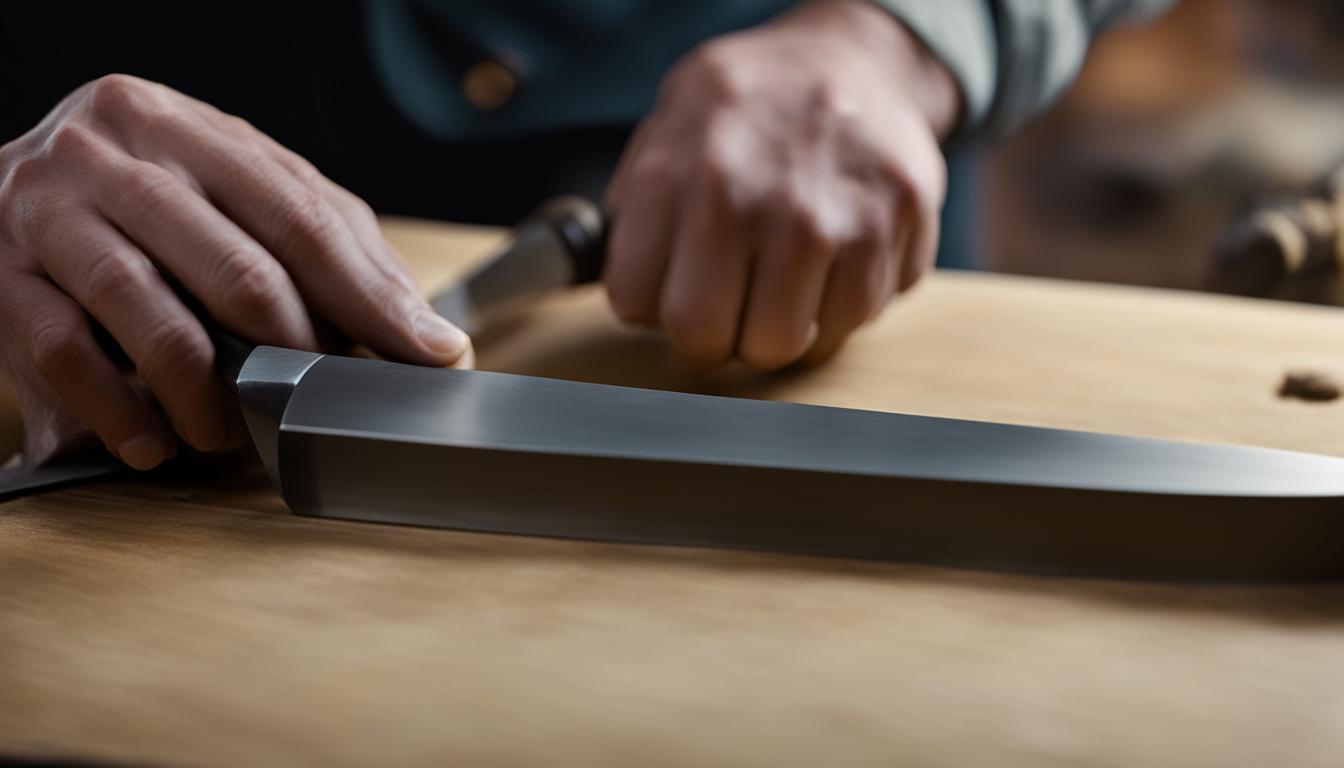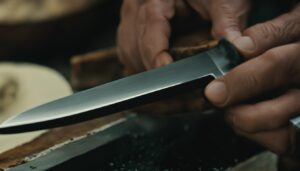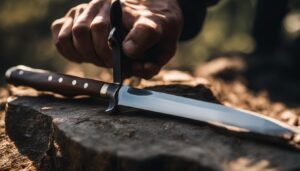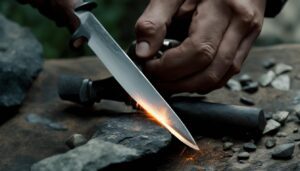Hunting knives are an essential tool for any hunter. They are used for skinning and dressing game, preparing food, and making shelter in the wilderness. Maintaining the sharpness of your hunting knife is crucial for optimal performance, safety, and efficiency in the field. In this article, we will explore proper knife honing techniques to ensure precision and durability in your hunting knives.
Key Takeaways:
- Proper knife honing techniques are essential for precision and durability in hunting knives.
- Regularly sharpening your hunting knife ensures optimal performance, safety, and efficiency in the field.
- Understanding different types of hunting knives and their sharpening techniques will help maintain their sharpness and longevity.
- There are various sharpening tools available for hunting knives, and choosing the right one depends on personal preference and skill level.
- Proper preparation, such as cleaning the blade and selecting the correct sharpening method, is necessary before sharpening your hunting knife.
Understanding the Importance of Knife Sharpening
Proper knife sharpening techniques are essential for maintaining the performance, precision, and durability of your hunting knives. A dull knife not only hinders your ability to cut through materials efficiently but can also pose safety risks. By regularly sharpening your hunting knife, you ensure that it remains sharp and ready for any task you encounter in the field.
Effective honing methods involve removing the bluntness of the blade and restoring its sharpness. This process not only improves the knife’s cutting performance but also ensures that you can work with accuracy and precision. Sharpening your hunting knife allows you to complete tasks more efficiently, such as skinning and dressing game or preparing food during your hunting expeditions.
“A sharp knife is not only a useful tool, but it is also a safer one. A dull knife requires more force to cut through materials, increasing the risk of slips and accidents. Knife sharpening is crucial for maintaining a sharp edge that enhances your cutting experience and minimizes the chances of injuries.”
There are various knife sharpening techniques you can utilize, depending on your preference and the tools available. These techniques can range from using a whetstone to utilizing guided sharpening systems or electric sharpeners. Each method offers its advantages and requires a different level of skill.
By understanding the importance of knife sharpening and exploring effective honing methods, you can ensure that your hunting knives remain in optimal condition throughout your outdoor adventures. In the following sections, we will delve into the different types of hunting knives, their sharpening techniques, and the various sharpening tools available, providing you with the knowledge to keep your blades sharp and ready for action.
Table: Different Knife Sharpening Techniques
| Technique | Description |
|---|---|
| Whetstone | A traditional method that involves using a sharpening stone to grind and hone the knife blade. |
| Honing Rod | A steel rod used to realign and straighten the knife’s edge, enhancing its cutting performance. |
| Electric Sharpener | A motorized device that automates the sharpening process, providing convenience and speed. |
| Pull-Through Sharpener | A handheld tool with preset angles and sharpening slots, making it easy to sharpen your knife with a few simple motions. |
| Guided Sharpening System | A system that allows you to maintain a consistent angle while sharpening, ensuring precise and uniform results. |
Different Types of Hunting Knives and Their Sharpening Techniques
When it comes to hunting knives, there are various types available, each with its own unique design and purpose. Understanding the different types of hunting knives is crucial for selecting the right sharpening technique to maintain their sharpness and effectiveness.
Drop Point Knives: These knives have a blade with a convex curve, making them ideal for general-purpose hunting tasks. The sharpening technique for drop point knives involves maintaining a consistent angle along the entire edge of the blade while using a sharpening stone or honing rod.
Clip Point Knives: Clip point knives have a concave curve near the tip of the blade, which makes them suitable for detailed work and piercing. To sharpen a clip point knife, it is important to pay extra attention to the curved area near the tip to ensure an even and sharp edge.
Gut Hook Knives: Gut hook knives feature a small hook on the spine of the blade, specifically designed for field dressing game. When sharpening a gut hook knife, focus on maintaining a sharp edge on the main blade and be cautious when sharpening the hook to avoid removing too much material.
Bowie Knives: Bowie knives have a long, curved blade with a clip point, making them versatile for various hunting and outdoor tasks. Sharpening a Bowie knife involves following the curvature of the blade and paying attention to the tip and concave area near the clip point.
Skinning Knives: Skinning knives have a narrow, curved blade, making them ideal for removing the skin from game. To sharpen a skinning knife, focus on creating a fine, razor-sharp edge along the entire length of the blade, ensuring smooth and precise skinning.
Table: Different Types of Hunting Knives and Their Sharpening Techniques
| Knife Type | Blade Design | Sharpening Technique |
|---|---|---|
| Drop Point Knives | Convex Curve | Maintain a consistent angle along the entire edge using a sharpening stone or honing rod |
| Clip Point Knives | Concave Curve near the tip | Pay extra attention to the curved area near the tip for an even and sharp edge |
| Gut Hook Knives | Small hook on the spine of the blade | Focus on maintaining a sharp edge on the main blade and be cautious when sharpening the hook |
| Bowie Knives | Long, curved blade with a clip point | Follow the curvature of the blade and pay attention to the tip and concave area near the clip point |
| Skinning Knives | Narrow, curved blade | Create a fine, razor-sharp edge along the entire length of the blade for smooth and precise skinning |
Various Sharpening Tools for Hunting Knives
When it comes to sharpening your hunting knife, there are several tools available that can help you achieve a razor-sharp edge. Each tool has its advantages and disadvantages, so choosing the right one depends on personal preference and skill level. Let’s take a closer look at some of the most common sharpening tools for hunting knives:
1. Sharpening Stones
Sharpening stones, also known as whetstones, are a traditional and effective tool for honing hunting knives. They come in different grit levels, which determine the coarseness of the stone. Coarse stones are used for reprofiling or repairing damaged blades, while finer stones are used for fine-tuning and polishing the edge. When using a sharpening stone, it’s important to maintain a consistent angle and apply light pressure to achieve optimal results.
2. Honing Rods
Honing rods, also known as sharpening steels, are long, cylindrical rods made of steel or ceramic. They are primarily used for realigning the blade’s edge between sharpenings. By running the blade along the honing rod at the correct angle, you can restore its sharpness and improve cutting performance. Honing rods are a quick and easy sharpening tool, making them popular among hunters who need to touch up their knives in the field.
3. Electric Sharpeners
Electric sharpeners are a convenient option for hunters who want fast and consistent results. These sharpeners use rotating abrasive discs or belts to sharpen the knife blade. Electric sharpeners are easy to use and can handle a variety of blade types. However, they may remove more metal from the blade compared to other sharpening methods, so caution is needed to avoid over-sharpening.
4. Pull-Through Sharpeners
Pull-through sharpeners are compact and user-friendly tools that are great for beginners. They consist of a pair of sharpening wheels or rods set at a specific angle. To sharpen the knife, you simply pull the blade through the slots in the sharpener. Pull-through sharpeners are designed to maintain a consistent angle and provide quick results. However, they may not be suitable for knives with curved or serrated blades.
5. Guided Sharpening Systems
Guided sharpening systems are comprehensive kits that provide precise and controlled sharpening. They typically include a guide or clamp that holds the knife at the correct angle, ensuring consistent results. These systems often come with different sharpening stones or abrasive pads to accommodate various grit levels. Guided sharpening systems are a great choice for users who want a foolproof and efficient sharpening process.
Choosing the right sharpening tool for your hunting knife depends on your needs, skill level, and personal preference. It’s important to invest in a high-quality tool and practice proper sharpening techniques to keep your hunting knife in optimal condition. Whether you choose a sharpening stone, honing rod, electric sharpener, pull-through sharpener, or guided sharpening system, regular maintenance and honing will ensure that your hunting knife performs at its best when you need it most.
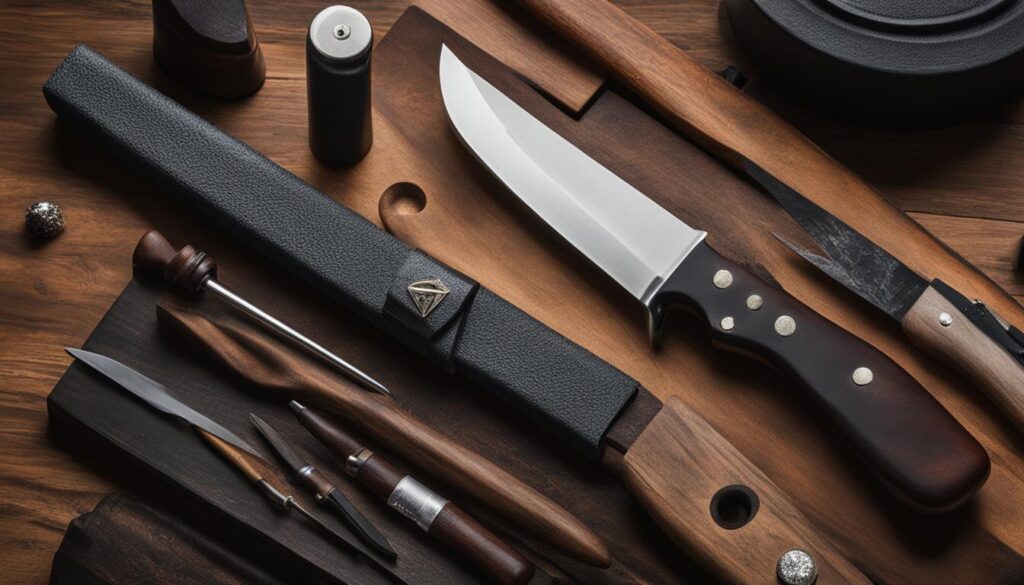
Preparing Your Hunting Knife for Sharpening
Before you begin sharpening your hunting knife, it is essential to properly prepare it. Taking the time to clean the blade, inspect for any nicks or chips, determine the correct sharpening angle, and select the appropriate sharpening method will ensure the best results.
To start, clean your hunting knife with warm, soapy water and a soft cloth. This will remove any dirt, debris, or residue that may have accumulated on the blade. Be sure to dry the knife thoroughly to prevent any rusting during the sharpening process.
Next, inspect the blade for any visible nicks or chips. These imperfections can affect the sharpening process and may require additional attention. If you notice any significant damage, it may be necessary to consult a professional for repairs.
Once your hunting knife is clean and free from any damage, determine the correct sharpening angle. This angle will vary depending on the type of knife you have and its intended purpose. Generally, a 20-degree angle is suitable for most hunting knives, but it’s important to refer to the manufacturer’s recommendations for your specific knife.
Finally, select the sharpening method that best suits your needs and skill level. There are various options available, including sharpening stones, honing rods, electric sharpeners, pull-through sharpeners, and guided sharpening systems. Each method has its advantages and disadvantages, so it’s important to choose one that you feel comfortable using and will yield the desired results.
By properly preparing your hunting knife for sharpening, you set yourself up for success. Cleaning the blade, checking for nicks or chips, determining the correct sharpening angle, and selecting the appropriate sharpening method are all crucial steps in achieving a sharp, durable edge that will enhance your hunting experience.
How to Sharpen a Hunting Knife Using a Whetstone
Proper knife honing techniques are essential for maintaining the sharpness and performance of your hunting knife. Using a whetstone is a traditional and effective method for achieving a razor-sharp edge. Follow these step-by-step instructions to master the art of sharpening your hunting knife using a whetstone.
Step 1: Prepare the Whetstone
Before you begin sharpening, soak the whetstone in water for approximately 10-15 minutes. This will help lubricate the stone and prevent any damage to the blade. Make sure the stone is secure and stable before you start.
Step 2: Hold the Knife Properly
Hold the knife firmly with your dominant hand, ensuring a secure grip. Rest your other hand on the blade, near the handle, to provide stability during the sharpening process. Position the blade at the desired angle, which is typically between 15-20 degrees, but can vary depending on the knife type and personal preference.
Step 3: Begin Sharpening
Starting at the base of the blade, place the edge against the whetstone. With moderate pressure, move the knife in a sweeping motion along the length of the stone, maintaining a consistent angle. Repeat this motion on both sides of the blade for an equal number of strokes to ensure even sharpening.
“Proper knife honing techniques are essential for maintaining the sharpness and performance of your hunting knife.”
Continue sharpening until you have achieved the desired level of sharpness. You can test the blade’s sharpness by gently running your finger across the edge, being extremely cautious to avoid injury. If the blade easily catches on your finger, it indicates a sharp edge.
Remember to clean the blade thoroughly after sharpening to remove any metal particles or debris. Properly store your hunting knife in a protective sheath or case when not in use to maintain its sharpness and longevity.


| Honing Method | Advantages | Disadvantages |
|---|---|---|
| Whetstone | Traditional method, provides a razor-sharp edge, cost-effective | Requires practice and skill to achieve optimal results |
| Honing Rod | Quick and convenient, ideal for maintaining sharpness during field use | Less effective for major blade restoration, may not provide a razor-sharp edge |
| Electric Sharpener | Efficient and easy to use, suitable for beginners | May remove more metal from the blade, potential for overheating and damaging the blade |
| Pull-Through Sharpener | Simple and user-friendly, provides consistent angle during sharpening | May not be suitable for all blade types, may remove more metal from the blade |
| Guided Sharpening System | Ensures consistent angle and precise sharpening, suitable for beginners | Higher cost, requires additional equipment |
Conclusion
Proper blade honing is the key to maintaining precision and durability in your hunting knives. By honing your knife skills, you can ensure optimal performance, safety, and efficiency in the field.
Understanding the importance of knife sharpening is the first step towards honing your hunting knives effectively. Regular sharpening not only enhances the cutting ability of your knives but also makes your outdoor activities safer and more efficient.
Different types of hunting knives require specific sharpening techniques. By familiarizing yourself with the proper honing methods for each knife type, you can maintain their sharpness and prolong their lifespan.
Choosing the right sharpening tool is crucial. Whether you prefer sharpening stones, honing rods, or electric sharpeners, selecting the tool that suits your needs and skill level will ensure consistent and excellent results.
Before sharpening your hunting knife, proper preparation is essential. Take the time to clean the blade, inspect for any damages, determine the correct sharpening angle, and select the appropriate method. These steps will set the foundation for a successful honing session.
Sharpening your hunting knife using a whetstone is a traditional yet effective technique. By following the step-by-step guide provided in this article, you can master the art of proper knife honing and achieve a razor-sharp edge.
It’s time to elevate your hunting experience by honing your knife skills. Remember, proper blade honing is essential for precision and durability. Start implementing these techniques today and enjoy the benefits of a sharp and reliable hunting knife on your next expedition.
FAQ
Why is sharpening a hunting knife important?
Sharpening a hunting knife is crucial for optimal performance, safety, and efficiency in the field. A dull knife can make hunting and other outdoor activities more difficult, dangerous, and time-consuming.
How often should I sharpen my hunting knife?
Regularly sharpening your hunting knife ensures optimal performance, precision, and durability. The frequency of sharpening depends on factors such as frequency of use, type of game being hunted, and personal preference.
Are there different techniques for sharpening different types of hunting knives?
Yes, different blade designs, such as drop point, clip point, gut hook, Bowie, and skinning knives, may require specific sharpening techniques. Understanding how each knife type should be sharpened will help maintain their sharpness and longevity.
What are the different types of sharpening tools available for hunting knives?
There are several types of sharpening tools available, including sharpening stones, honing rods, electric sharpeners, pull-through sharpeners, and guided sharpening systems. The choice of tool depends on personal preference and skill level.
How do I prepare my hunting knife for sharpening?
Proper preparation is essential before sharpening your hunting knife. This includes cleaning the blade, checking for nicks and chips, determining the correct angle for sharpening, and selecting the appropriate sharpening method.
How do I sharpen a hunting knife using a whetstone?
Using a whetstone is a traditional and effective method for sharpening hunting knives. The process involves holding the stone securely, maintaining a consistent angle, applying light pressure, and honing the blade with a rod to achieve a razor-sharp edge.
